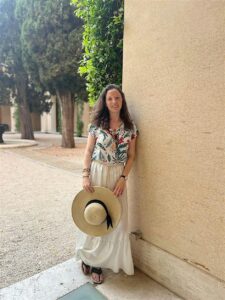Emily Lord-Kambitsch, Ph.D., the Associate Chair and Research Coordinator of the Mythological Studies Program, recently spent a year in Rome. I’m delighted to hear about her experiences of studying myth and depth psychology in Italy. To find out more about the M.A./Ph.D. in Mythological Studies with Emphasis in Depth Psychology, visit us here.
Angela Wood: For those who don’t know, how did this year of study in Italy come about, and what was your academic mission in doing so?
Emily Lord-Kambitsch: It was a fortuitous boon from the universe! My partner won a fellowship at the American academy at Rome so that he could finish his book project on 19th and early 20th century translations of Dante’s Divine Comedy into Italian dialects, and the Academy is generous enough to welcome partners (“fellow travelers”) and give them resources for academic study. While maintaining full-time work at Pacifica on a mostly remote basis (thank you, Pacifica, for supporting this arrangement!) I was able to undertake some fulfilling site-specific research.
I have a long-standing interest in myth and spatiality, or the ways in which stories are inspired by places, or infuse places with spiritual and psychological power. I have long been fascinated by the ancient Roman poet Ovid’s ability to transform the city of Rome into an urban landscape for facilitating transgressive love affairs in the Ars Amatoria, or Art of Love. Ovid was exiled for that poem for its playful encouragement of illicit love affairs in the time of the Emperor Augustus, who was launching a set of moral laws regulating marriage, adultery, and other relational behaviors and contracts. The first part of the poem takes the reader on an immersive tour of places in Rome where one can find erotic partners. It’s very edgy and exciting. For a good part of the Fall I would take walks around the city, mapping my steps according to the places Ovid directed his readers’ attention. Sometimes physical ruins of those places remained and other times I could only attempt to catch a psychological or symbolic remnant of them. That was really fun and led to me presenting a paper at a conference at John Cabot University in Rome on the neighborhood where I was living (Trastevere and the Gianicolo) and the erotic meeting places Ovid assigns to this. The whole conference was on the history of this neighborhood, and it was really fascinating to see the architectural, literary, and cultural movements that had occurred there since Ovid.
Angela: What was it like to live at the American Academy in Rome, which I understand occupies the ancient sanctuary of Janus?

Emily: The American Academy of Rome is located on the Gianicolo, one of the seven hills of Rome. It was not incorporated into the city until Augustus was emperor, and was historically a hinterland subject to Etruscan raids. It was a liminal place populated by many artisans, foreigners, and enslaved and formerly enslaved people. It had a sanctuary to the goddess of fortune, who was particularly concerned with the welfare of enslaved people and their hope of manumission (according to Ovid’s poem Fasti), so definitely a place for people who were marginalized or in a condition of “social death” (as sociologist Orlando Patterson assigns enslavement). Somewhere on the hill of the Gianicolo (Janiculum in Latin) there was also a shrine to Janus, the two-headed god of doorways and thresholds, beginnings and endings. In Ovid’s Fasti Book 1, Janus says he was the primordial force of chaos, the mass from which everything was created and took shape.
The city walls near the Academy gave the sense of a frontier, a borderland. We would go to this neighborhood bar, Bar Gianicolo, which the locals call affectionately “Bar G,” and it’s in this roundabout with a lot of traffic, and it feels like a way station, the last place of nourishment before you go out into the wild. I did feel that sense of threshold when I was there. There was also the necropolis, a burial ground near there in antiquity, and the walls of the inner courtyard in the Academy are covered with funereal inscriptions to loved ones who died. They surrounded us as we had meals outdoors in the summer; we were surrounded by the dead. The Academy is also a place where people are at a threshold moment in their careers, writing books, creating architecture and art that’s supposed to break new ground. So, it’s a threshold place for the people who come there as well.
Angela: As a mythologist, what was it like to visit the Sacred Wood, a garden created with the intent to puzzle, disorient, and amaze visitors, with residents including giant carvings of an ogre head, a dragon, Hercules, and other mythological creatures?
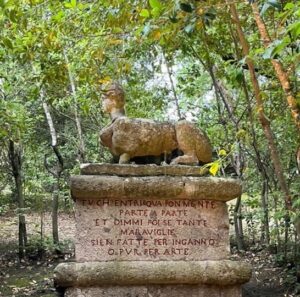
Emily: I had the pleasure of visiting the Sacro Bosco with the historian Antonio Rocca, who wrote the book Bomarzo. Guida al Sacro Bosco. I couldn’t experience the place properly without the context he brought, which was really helpful. The whole place was built by Pier Francesco (Vicino) Orsini in the mid-sixteenth century. The design of the park was inspired by philosopher Giulio Camillo’s Theatre of Memory (or L’Idea del Theatro), which emphasized the hermetic journey of creating matter and consciousness. The figures in the Sacred Wood represent aspects of consciousness at different stages of the journey. It starts with these two sphinxes that flank the entrance, and they have an inscription that says, “Enter here carefully and then tell me if all these figures you’ll see are tricks or art.” So you’re asking yourself, am I being tricked, initiated, or just appreciating art? The sphinxes are a signal of entering another world, a place of knowledge, and you have to set aside your normal perceptions. Another of the signals of consciousness raising is the theater in stone, which has seven stairs and seven doorways. Seven is meant to represent the seven stages of creation that Camillo addresses in his book, the seven portals through which consciousness is formed. All the figures in the garden play a role in this process.
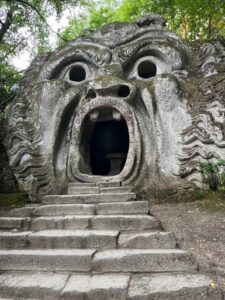
One of the last images you see as you walk through the Sacro Bosco is called the Door to Hell, and it’s a huge mouth with these fangs and you can actually go inside the mouth. That’s probably the most dramatic! After that, you ascend to this high level and it’s an emergence from this underworld journey. You can look below and see an overview of all the statues you’ve seen, all the places you have visited in your own consciousness (perhaps all of the tricks you have played on yourself as per the Sphinx’s caveat?).
Angela: I understand you visited the mosaics of Ravenna. What was it like to behold mosaics that James Hillman wrote about at the end of his life? What did you come away with from the experience?
Emily: It was the most beautiful synchronicity to discover James Hillman’s association with those mosaics in Ravenna itself. I went to the city with the Academy. It was a spring trip, guided expertly by Caroline Goodson, the Academy’s Mellon Professor, who led a series of exciting walking tours throughout the year. Ravenna was the first stop on our visit to the region of Emilia-Romagna, an area widely known for wine making, balsamic vinegar, a lot of good food, and also for Renaissance art (the Caracci brothers, for instance, were active in nearby Bologna). Ravenna is famous for its collection of mosaics, mostly 5th and 6th century, early Christian, many of which were commissioned by the ruler of Ravenna, Theodoric the Great, King of the Ostrogoths, to infuse sacred spaces with beauty both for the benefit of his own Arian Christian community and the community of the Orthodox Christians. The mosaics are all very beatific. I saw no images of hell or the inferno; they’re all very serene, lush paradisiacal places, with lots of stars and celestial scenes as well.
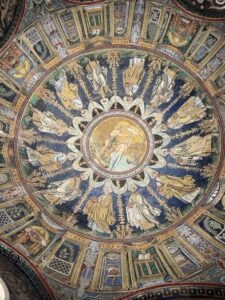
On our first day in Ravenna, my partner and I were in a bookshop and I happened upon a book with famed depth psychologist James Hillman’s name on it, and I wondered what he was doing in Ravenna! The book, entitled L’ultima immagine (The Final Image) turned out to be a collection of dialogues with Professor Silvia Ronchey, a historian of the Byzantine period based in Rome from when the two ventured to Ravenna together to experience and think about the metaphysical power of the famous mosaics. They provide a holistic and emotionally stirring interpretation of the images and their soulful and historical meaning. This book is also very special because, as the beautiful Foreword written by James Hillman’s wife Margot McLean explains, her husband was nearing death when he and Silvia Ronchey finished writing the book together several years after their visit to Ravenna. Hence the book includes dialogues about death, the power of images, soul-making, and other topics, some of Hillman’s final reflections, which are interspersed with the dialogues about Ravenna. Reading this book added a deep poignancy to the mosaics as I experienced them in Ravenna, and gave me great respect for the relationship of soulful inquiry between Ronchey and Hillman. I was also fortunate enough to meet Silvia Ronchey when I was in Rome, and I am deeply grateful for her hospitality and insight.
Angela: What was the importance of place in your experience? These days, it’s easy to virtually tour a place using satellite and street views online. How does being in the same physical space as the myths you’re studying impact your scholarship?
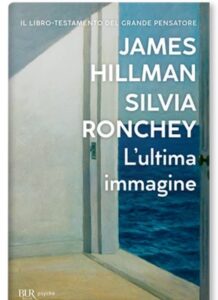
Emily: We don’t all have the privilege to travel to these places, so I wouldn’t say it’s essential to be in Rome to have an appreciation for the power of myth within it. But it is important to understand the association between stories and places in general, to try to learn more about the mythic traditions (in the U.S. this would be in many cases indigenous story traditions) that communicate the spiritual vitality of the landscape. The Chumash narratives I was exposed to in my early school days helped me to appreciate the vital influences of the Channel Islands, the sacred meeting places of the creeks and ocean, When I first studied Greek and Roman myth, I would try to find places in Santa Barbara that reminded me of the archetypal quality of those myths, like the sea foam as Aphrodite’s realm. Cult followings of deities in many spiritual traditions proliferated because people made ritual and other practical connections with the land they were living on and the numinous sense of the gods and goddesses. But if we are talking about learning more about the people who honored and told stories about the gods in a particular place, there is something special about being in the place where the stories happened, in my own studies especially a place like Pompeii or Athens, where the religious sanctuaries are so well persevered.
I would like to have a lasting relationship with Italy. It will take going there again to understand the subtleties of how the city reflects itself from Ovid’s time and other periods in the past. For instance, one landmark in Ovid’s tour is the Theater of Pompey in the Campo di Fiori area. The theater is gone, but the buildings are built in a curve, to replicate the shape of the theater that once stood there, so you have this interesting echo. I’m interested in going back to observe these subtle echoes and mapping them onto Ovid’s poem. Any place that we live or travel, there’s a lot of different existences over time that have led to what’s there now, and I’m interested less in the empirical and more in the intuitive and poetic imprint. What’s always been here and what’s still here.
Angela: How has this experience informed your teaching and scholarship, and what are you most looking forward to as the school year begins anew at Pacifica?
Emily: The experience has emphasized how efficient and powerful experiential learning is. A lot of my learning in Rome was through experience and being in the right place at the right time to learn certain things. As Pacifica students will also know, in graduate school, learning is less about absorbing lectures and more about integrating what you’re learning with the knowledge you already have and finding your own way as a scholar. The experience in Italy made me want to do more experiential work in class and more research-skill building exercises too. In the winter I’m teaching Greek tragedy in language, theory, and practice, which is a new course about studying ancient tragedy in part through the study of theoretical approaches to the topic from depth psychology and elsewhere, and in part through scene work and developing monologues, syncing story with embodiment and creative writing. This past year’s journey has helped me think more deeply about that.
Angela: Thank you so much for sharing your experience in Italy with us, and I look forward to seeing how you synthesize your travels into your work.
The M.A./Ph.D. in Mythological Studies with Emphasis in Depth Psychology is now accepting applications. Find out more here.
Emily Lord-Kambitsch, Ph.D., is Assistant Professor, Associate Chair, and Research Coordinator of the Mythological Studies Program at Pacifica Graduate Institute. A scholar, poet-storyteller, and native of Santa Barbara, her lifelong exploration of classical mythology is rooted in the study of Greek and Latin language and literature. Emily arrived in Pacifica’s Myth Program in 2020, after 8 years in the UK and a series of lectureships at UCL and UCSB. At Pacifica she teaches courses in Greco-Roman myth, memoir and self-writing, research approaches, and dissertation formulation. Emily has ceaseless curiosity about nature, numinous experience, spiritual agency, Greco-Roman myth, memory, and the transmission of story and artifacts, personal and ancestral, and is passionate about supporting students’ connection with the perennial stories that call to them through academic, artistic, and personal lenses.

Angela Wood is a writer for Pacifica Graduate Institute, as well as the editor of the Santa Barbara Literary Journal. Her work has been published in Food & Home, Peregrine, Hurricanes & Swan Songs, Delirium Corridor, Still Arts Quarterly, Danse Macabre, and is forthcoming in The Tertiary Lodger and Running Wild Anthology of Stories, Vol. 5.


